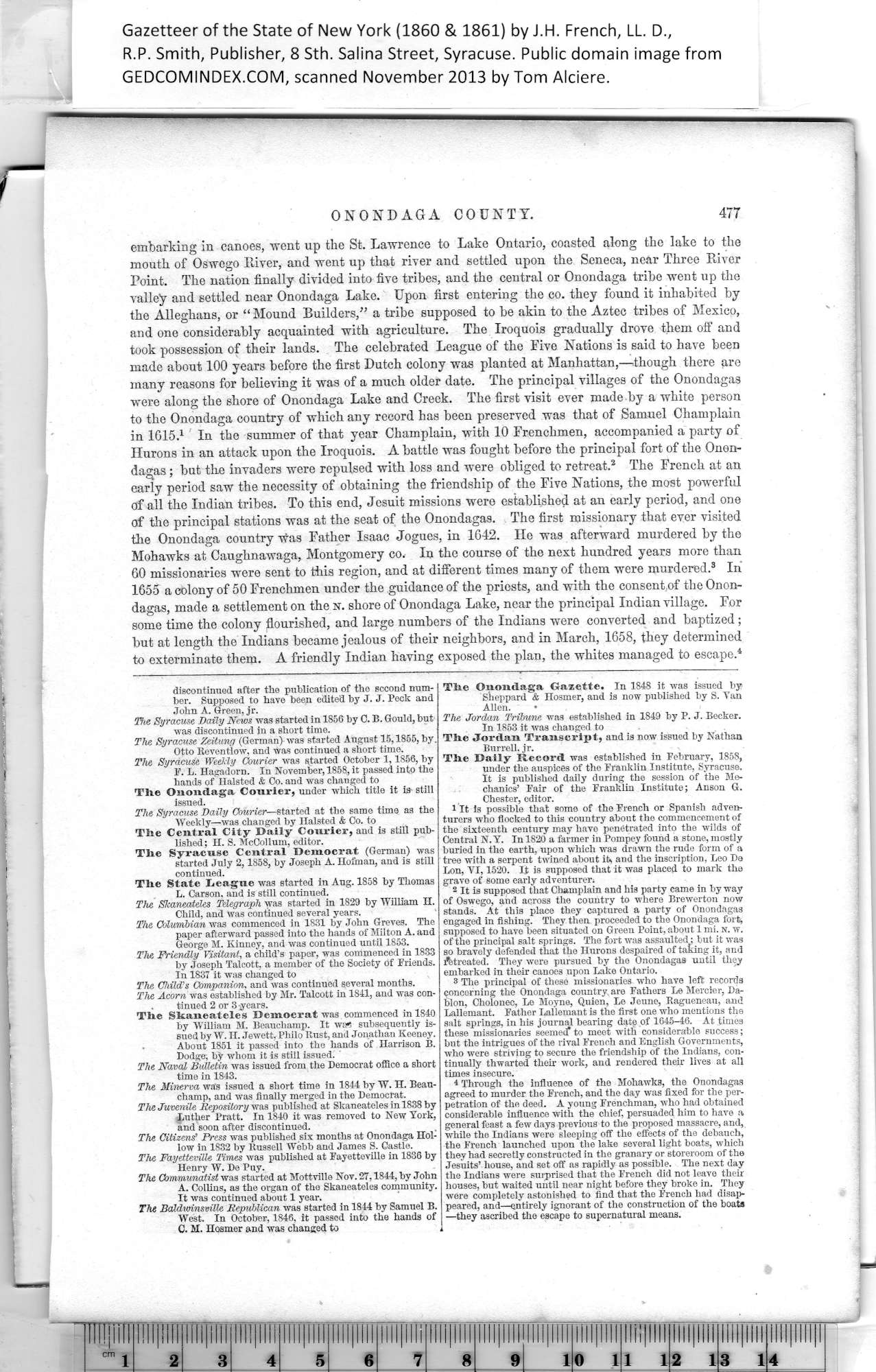|
discontinued after the publication of the second num¬
ber. Supposed to have been edited by J. J. Peck and
John A. Green, jr.
The Syracuse Daily News was started in 1856 by 0. B. Gould, but
was discontinued in a short time.
The Syracuse Zeitung (German) was started August 15,1855, by.
Otto Reventiow, and was continued a short time.
The Syracuse Weekly Courier was started October 1, 1856, by
P. L. Hagadorn. In November, 1858, it passed into the
hands of Halsted & Co. and was changed to
Tlie Onondaga Courier, under which title it is still
issued.
The Syracuse Daily Courier—started at the same time as the
Weekly—was changed by Halsted & Co. to
Tlie Central City Daily Conrier, and is still pub¬
lished; H. S. McCollum, editor.
Tlie Syracuse Central Democrat (German) was
started July 2, 1858, by Joseph A. Hofman, and is still
continued.
Tlie State League was started in Aug. 1858 by Thomas
L. Carson, and is still continued.
The Skaneateles telegraph was started in 1829 by William H.
Child, and was continued several years.
The Columbian was commenced in 1831 by John Greves. The
paper afterward passed into the hands of Milton A. and
George M. Kinney, and was continued until 1853.
The Friendly Visitant, a child’s paper, was commenced in 1833
by Joseph Talcott, a member of the Society of Eriends.
In 1837 it was changed to
The Child’s Companion, and was continued several months.
The Acorn was established by Mr. Talcott in 1841, and was con¬
tinued 2 or 3 -years.
Tlie Skaneateles Democrat was commenced in 1840
by William M. Beauchamp. It wo*; subsequently is¬
sued by W. II. Jewett, Philo Rust, and Jonathan Keeney.
About 1851 it passed into the hands of Harrison B.
Dodge, by whom it is still issued.
The Naval Bulletin was issued from the Democrat office a short
time in 1843.
The Minerva was issued a short time in 1844 by W. H. Beau¬
champ, and was finally merged in the Democrat.
The Juvenile Repositoryw&s published at Skaneateles in 1838 by
Luther Pratt. In 1840 it was removed to New York,
and soon after discontinued.
The Citizens’ Press was published six months at Onondaga Hol¬
low in 1832 by Russell Webb and James S. Castle.
The Fayetteville Times was published at Fayetteville in 1836 by
Henry W. De Puy.
The Communatist was started at Mottville Nov. 27,1844, by John
A. Collins, as tho organ of the Skaneateles community.
It was continued about 1 year.
The Baldwinsville Republican was started in 1844 by Samuel B.
West. In October, 1846, it passed into the hands of
C. M. Hosmer and was changed to |
The Onondaga Gazette. In 1848 it was issued by
Sheppard & Hosmer, and is now published by S. Van
Allen. •
The Jordan Tribune was established in 1849 by P. J. Becker.
In 1853 it was changed to
Tke Jordan Transcript, and is now issued by Nathan
Burrell, jr.
The Daily Record was established in February, 1858,
under the auspices of the Franklin Institute, Syracuse.
It is published daily during the session of the Me¬
chanics’ Fair of the Franklin Institute; Anson G.
Chester, editor.
1 It is possible that some of the French or Spanish adven¬
turers who flocked to this country about the commencement of
the sixteenth century may have penetrated into the wilds of
Central N.Y. In 1820 a farmer in Pompey found a stone, mostly
buried in the earth, upon which was drawn the rude form of a
tree wTith a serpent twined about it, and the inscription, Leo Da
Lon, VI, 1520. It is supposed that it was placed to mark the
grave of some early adventurer;
2 It is supposed that Champlain and his party came in by way
of Oswego, and across the country to where Brewerton now
stands. At this place they captured a party of Onondagas
engaged in fishing. They then proceeded to the Onondaga fort,
supposed to have been situated on Green Point, about 1 mi. u. w.
of the principal salt springs. The fort was assaulted; but it was
so bravely defended that the Hurons despaired of taking it, and
Retreated. They were pursued by the Onondagas until they
embarked in their canoes upon Lake Ontario.
3 The principal of these missionaries ■who have left records
concerning the Onondaga country, are Fathers Le Meroier, Pa-
blon, Cholonec, Le Moyne, Quien, Le Jeune, Ragueneau, and
Lallemant. Father Lallemant is the first one -who mentions the
salt springs, in his journal bearing date of 1645-46. At times
these missionaries seemed* to meet with considerable success;
but the intrigues of the rival French and English Governments,
who were striving to secure the friendship of the Indians, con¬
tinually thwarted their work, and rendered their lives at all
times insecure.
4 Through the influence of the Mohawks, the Onondagas
agreed to murder the French, and the day was fixed for the per¬
petration of the deed. A young Frenchman, who had obtained
considerable influence with the chief, persuaded him to have a
general feast a few days previous to the proposed massacre, and,
while the Indians were sleeping off the effects of the debauch,
the French launched upon the lake several light boats, which
they had secretly constructed in the granary or storeroom of the
Jesuits’ house, and set off as rapidly as possible. The next day
the Indians were surprised that the French did not leave their
houses, but waited until near night before they broke in. They
were completely astonished to find that the French had disap¬
peared, and—entirely ignorant of the construction of the boats
—they ascribed the escape to supernatural means. |
